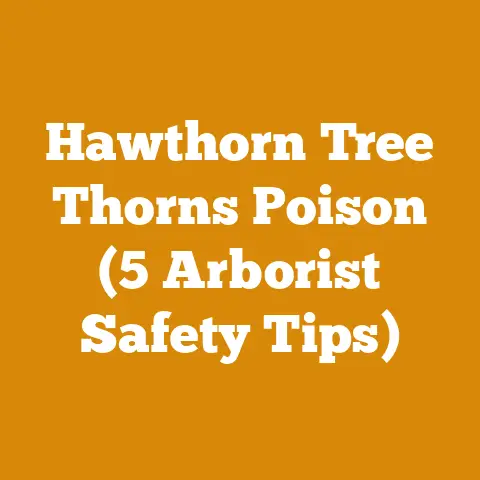Wood Stoves and Allergies (5 Expert Tips to Reduce Irritation)
Have you ever felt the warmth of a wood stove, the crackling fire painting dancing shadows on the wall, only to be met with a scratchy throat, watery eyes, and a symphony of sneezes? It’s a cruel irony – seeking comfort but finding discomfort. For many, the dream of cozy evenings by the fire is often disrupted by the harsh reality of allergies and irritations. I understand that frustration. I’ve spent years working with wood, from felling trees in the crisp mountain air to splitting logs under the summer sun, and I’ve seen firsthand how wood smoke can affect people differently. It’s not just about the wood; it’s about understanding the science behind it, the techniques we use, and how we can mitigate the risks. I’m going to share my experiences and knowledge to help you enjoy the warmth of your wood stove without the allergic woes.
Wood Stoves and Allergies: 5 Expert Tips to Reduce Irritation
The intersection of wood stoves and allergies is a complex one, involving everything from the type of wood you burn to the cleanliness of your stove. I’ve distilled years of experience and research into these five key tips.
1. Choosing the Right Wood: A Matter of Species and Seasoning
The type of wood you burn has a significant impact on the amount and composition of smoke produced. This is where the science of wood processing meets the practicalities of allergy management.
Hardwood vs. Softwood: A Tale of Two Trees
- Hardwoods: Generally, hardwoods like oak, maple, ash, and birch are preferable for wood stoves. They are denser, burn longer, and produce less smoke than softwoods.
- Technical Detail: Hardwoods have a higher density, typically ranging from 500 to 1000 kg/m3 at 12% moisture content.
- Softwoods: Softwoods like pine, fir, and spruce contain more resin, which leads to more smoke and creosote buildup in your chimney.
- Technical Detail: Softwoods usually range from 350 to 500 kg/m3 at 12% moisture content.
- Personal Story: I once made the mistake of burning a large quantity of pine scraps in my own stove. The creosote buildup was so significant that I had to hire a professional chimney sweep much sooner than anticipated. It was a costly lesson in wood selection.
The Importance of Seasoning: Drying for a Cleaner Burn
Seasoning, or drying, wood is crucial for reducing smoke and allergens. Green wood contains a high moisture content, which leads to incomplete combustion and increased smoke production.
- Technical Requirement: Firewood should have a moisture content of 20% or less for optimal burning.
- Measurement: Use a wood moisture meter to accurately assess the moisture content. These are readily available and relatively inexpensive.
- Drying Time: The drying time varies depending on the wood species, climate, and storage conditions. Generally, hardwoods require at least 6-12 months of seasoning. Softwoods may dry faster, but I still recommend at least 6 months.
- Data Point: Studies have shown that burning properly seasoned wood can reduce particulate matter emissions by up to 70% compared to burning green wood.
- Practical Tip: Stack your wood in a single layer, off the ground, and in a well-ventilated area. Cover the top of the stack to protect it from rain and snow.
- Personal Story: I remember helping a friend prepare for winter by stacking firewood. He was impatient and wanted to burn the wood immediately. I convinced him to wait, and he was amazed at how much cleaner and hotter the seasoned wood burned compared to the green wood he had used in previous years.
Wood Selection Criteria: A Summary
| Wood Type | Density (kg/m3 at 12% MC) | Resin Content | Smoke Production | Seasoning Time (Months) |
|---|---|---|---|---|
| Oak | 700-900 | Low | Low | 12+ |
| Maple | 600-800 | Low | Low | 9-12 |
| Ash | 650-850 | Low | Low | 9-12 |
| Birch | 600-750 | Low | Low | 6-9 |
| Pine | 350-450 | High | High | 6+ |
| Fir | 400-500 | Medium | Medium | 6+ |
| Spruce | 350-450 | Medium | Medium | 6+ |
2. Optimizing Stove Operation: The Art of Clean Burning
Even with the best wood, improper stove operation can lead to increased smoke and allergens. Understanding the principles of clean burning is essential.
Airflow Management: The Key to Complete Combustion
- Primary Air: Controls the rate at which wood burns. Too little air, and the fire will smolder, producing smoke. Too much air, and the fire will burn too quickly, wasting fuel.
- Secondary Air: Introduces preheated air into the firebox to burn off the gases and particles that would otherwise escape as smoke.
- Technical Requirement: Most modern wood stoves have adjustable air controls. Consult your stove’s manual for specific recommendations.
- Practical Tip: Start with the air controls fully open to establish a hot fire. Once the fire is burning well, gradually reduce the primary air to maintain a steady burn.
- Data Point: Properly adjusted airflow can reduce smoke emissions by up to 50%.
Burn-Down Technique: Reducing Smoke at the End of the Burn
- Description: Allow the fire to burn down to embers before reloading the stove. This ensures that all the wood is fully combusted, minimizing smoke.
- Practical Tip: Rake the embers forward and add new wood to the back of the firebox. This allows the new wood to ignite slowly and evenly.
Creosote Management: Preventing Buildup
- Creosote Formation: Creosote is a flammable substance that forms when unburned gases and particles condense in the chimney.
- Technical Requirement: Chimneys should be inspected and cleaned at least once a year, or more frequently if you burn a lot of wood.
- Safety Code: NFPA 211 is the standard for chimneys, fireplaces, vents, and solid fuel-burning appliances. It provides detailed requirements for chimney construction, installation, and maintenance.
- Personal Story: I once neglected to clean my chimney for two years. The creosote buildup was so thick that it significantly reduced the draft and increased the risk of a chimney fire. It was a scary experience that taught me the importance of regular chimney maintenance.
3. Enhancing Indoor Air Quality: Beyond the Stove
The air inside your home can be affected by factors beyond the wood stove itself. Taking steps to improve indoor air quality can further reduce allergy symptoms.
Ventilation: Bringing in Fresh Air
- Importance: Proper ventilation helps to dilute indoor pollutants, including smoke particles.
- Practical Tip: Open windows and doors for a few minutes each day, even in cold weather.
- Technical Detail: Consider installing a heat recovery ventilator (HRV) or energy recovery ventilator (ERV) to provide continuous ventilation without significant energy loss.
Air Filtration: Removing Airborne Particles
- HEPA Filters: High-efficiency particulate air (HEPA) filters can remove up to 99.97% of particles as small as 0.3 microns.
- Technical Specification: HEPA filters must meet specific performance standards, including a minimum efficiency reporting value (MERV) of 17 or higher.
- Air Purifiers: Portable air purifiers with HEPA filters can be used to clean the air in specific rooms.
- Furnace Filters: Replace your furnace filter regularly with a high-efficiency filter.
- Data Point: Studies have shown that air purifiers with HEPA filters can significantly reduce indoor particulate matter concentrations.
Humidity Control: Maintaining Optimal Levels
- Dry Air: Dry air can irritate the respiratory system, making allergy symptoms worse.
- Humidifiers: Use a humidifier to maintain a relative humidity level of 30-50%.
- Data Point: Maintaining optimal humidity levels can reduce the survival and spread of airborne viruses and allergens.
Regular Cleaning: Removing Dust and Allergens
- Dusting: Dust surfaces regularly to remove accumulated dust and allergens.
- Vacuuming: Vacuum carpets and rugs frequently with a vacuum cleaner equipped with a HEPA filter.
- Washing: Wash bedding and curtains regularly to remove dust mites and other allergens.
4. Personal Protective Measures: Shielding Yourself from Allergens
Even with the best wood and stove operation, some individuals may still experience allergy symptoms. Taking personal protective measures can help to minimize exposure.
Respirators: Filtering Out Particles
- N95 Respirators: N95 respirators can filter out at least 95% of airborne particles.
- Technical Requirement: N95 respirators must be NIOSH-approved.
- Proper Fit: Ensure that the respirator fits snugly against your face to prevent leakage.
- Practical Tip: Wear a respirator when handling firewood, cleaning the stove, or performing chimney maintenance.
Clothing: Preventing Allergen Transfer
- Protective Clothing: Wear long sleeves, long pants, and gloves when handling firewood.
- Washing: Wash your clothes immediately after handling firewood to remove allergens.
- Personal Story: I used to dismiss the importance of wearing gloves when handling firewood, until I developed a severe rash on my hands from contact with certain types of wood. Now, I always wear gloves.
Eye Protection: Preventing Irritation
- Safety Glasses: Wear safety glasses to protect your eyes from smoke and debris.
- Goggles: Goggles provide even better protection, especially when cleaning the stove or chimney.
Limiting Exposure: When to Avoid the Stove
- High Allergy Days: On days when pollen counts are high, consider avoiding the wood stove altogether.
- Medical Advice: Consult with your doctor or allergist for personalized recommendations.
5. Stove and Chimney Maintenance: Ensuring Safe and Efficient Operation
Regular maintenance is essential for ensuring that your wood stove operates safely and efficiently, minimizing smoke and allergens.
Chimney Inspections: Detecting Potential Problems
- Frequency: Chimneys should be inspected at least once a year, or more frequently if you burn a lot of wood.
- Professional Inspection: Hire a qualified chimney sweep to perform a thorough inspection.
- Technical Requirement: The chimney should be free of obstructions and creosote buildup.
- Safety Code: NFPA 211 provides detailed requirements for chimney inspections.
Stove Cleaning: Removing Ash and Debris
- Frequency: Clean the stove regularly to remove ash and debris.
- Ash Disposal: Dispose of ash in a metal container with a tight-fitting lid.
- Practical Tip: Use a shop vacuum to remove ash from the firebox.
Gasket Replacement: Ensuring a Tight Seal
- Importance: Worn or damaged gaskets can allow smoke to leak into the room.
- Inspection: Inspect the door and glass gaskets regularly.
- Replacement: Replace gaskets as needed.
- Technical Specification: Use gaskets that are specifically designed for wood stoves.
Baffle Inspection: Ensuring Proper Combustion
- Importance: Baffles help to direct airflow and improve combustion efficiency.
- Inspection: Inspect the baffles regularly for cracks or damage.
- Replacement: Replace baffles as needed.
- Personal Story: I once had a stove with a cracked baffle. I didn’t realize it at first, but the stove was producing much more smoke than usual. Replacing the baffle made a significant difference in the stove’s performance.
Tool Calibration Standards
- Moisture Meter Calibration: Moisture meters should be calibrated regularly using a calibration block to ensure accurate readings. The calibration block should provide a known moisture content level (e.g., 18%).
- Thermometer Calibration: Wood stove thermometers should be calibrated against a reference thermometer in boiling water (212°F or 100°C at sea level) to verify accuracy.
Safety Equipment Requirements
- Chainsaw Safety: When cutting firewood, always wear appropriate safety gear, including a helmet, eye protection, hearing protection, gloves, and chainsaw chaps.
- Wood Splitting: Use a wood splitter with safety guards to prevent injuries. Wear safety glasses and gloves.
Case Study: Reducing Allergens in a Rural Home
I worked with a family in a rural area who were struggling with allergy symptoms related to their wood stove. They were burning a mixture of hardwood and softwood, and their chimney had not been cleaned in several years.
- Intervention:
- We replaced their old wood stove with a new, EPA-certified model.
- Technical Detail: EPA-certified stoves are designed to burn more cleanly and efficiently, reducing emissions.
- We cleaned their chimney and installed a new chimney liner.
- We provided them with education on proper wood selection and seasoning.
- We helped them to improve their indoor air quality by installing a HEPA filter and a humidifier.
- We replaced their old wood stove with a new, EPA-certified model.
- Results: The family reported a significant reduction in allergy symptoms after the intervention. They were able to enjoy their wood stove without the discomfort they had previously experienced.
Conclusion
Enjoying the warmth and comfort of a wood stove doesn’t have to come at the expense of your health. By choosing the right wood, optimizing stove operation, enhancing indoor air quality, taking personal protective measures, and maintaining your stove and chimney, you can significantly reduce allergy symptoms and create a healthier and more enjoyable home environment. I hope that these tips will help you to experience the joys of wood burning without the allergic woes. Remember, it’s all about understanding the science, applying the techniques, and prioritizing your well-being.






